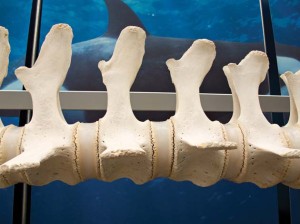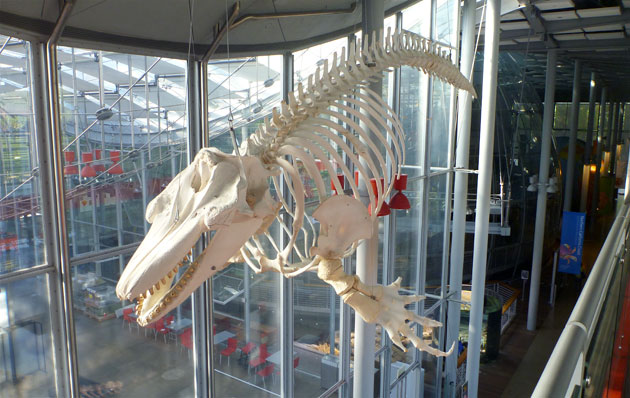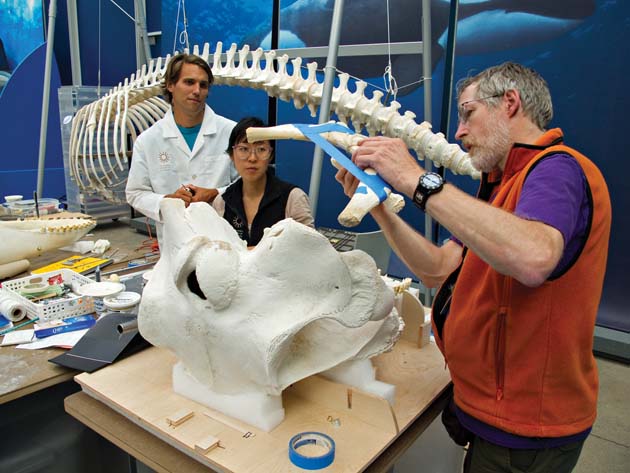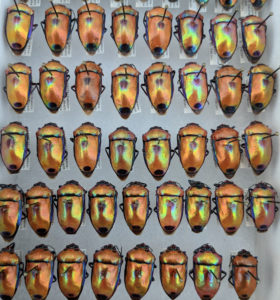n the late 1970s, a bicycle mechanic named Lee Post moved to Homer, Alaska to run a bookstore with his mother. Since it was a small shop that only really needed one employee at a time, he also volunteered at the town’s natural history museum. The museum had recently acquired a set of beaked whale bones, and museum staff had decided to try to put the whale back together again. But when it came time to actually do the deed, everyone was busy. So Post thought, well, I’ve repaired bikes — surely I can repair a whale skeleton if I have a book to follow, and conveniently, I run a bookstore.
He went back to the store and looked for books about reconstructing whale skeletons.
“There was no such thing,” he says.
Well, Post had spent some of his childhood on the East Coast, where every museum had a whale swinging from the rafters. He called around to ask for advice, assuming that someone must know the process.
“Turns out they didn’t,” he says. “Those whales were all done 100 years before by people that were long dead.”
Well, there were a few people on the West Coast who’d done whales recently. Post called them.
“I realized they were all doing it differently,” he says. “There was nothing consistent about how they were doing these things. Some of the methods, it was like, ‘Oh, man that’s janky. There’s got to be a better way of doing it.’”
If you are wondering why the California Academy of Sciences brought in a bookseller from Homer, Alaska to help lead the articulation of its rare orca skeleton — or if you are wondering how Lee Post became “Lee Post AKA The Boneman,” one of the world’s leading authorities on the re-putting-together of beached whales — that is how the story begins. With Lee Post, out of references, looking at a beaked whale skeleton he had pledged to reconstruct and thinking, “Well, I guess I’ll just do it myself.”
The Boneman went to work on the bones. Quickly, he discovered that he was in the perfect town for the job: Homer is full of artists, metal workers, woodworkers, machinists, and fishermen, an unlikely combination that meant that whenever Post got stuck on the project, he could consult a creative expert.
“So I’d be working at the bookstore, and everyone knew what I was doing because it’s a small town,” Post says. “I’d start collecting ideas from people on how to do things, we’d brainstorm these ideas and eventually something would make sense to me as the best way to go. We kind of reinvented the wheel.”
As Post worked, other stuff started to wash up. More whales, more dolphins, other mammals; they all needed Post’s newly acquired expertise. He did more. Soon teachers started coming through the museum and seeing what he was doing with the whales, and asking him to come help their classes fix up all manner of creatures. Post penned a series of books explaining his methods, which now total nine volumes of heavily illustrated how-to manuals with catchy titles: The Sperm Whale Engineering Manual, The Moose Manual, Building Bear Bones.
“I realized over the years that nobody has better ways of doing it than what we’re doing,” Post says. “It’s not like we’re in this little town in the middle of nowhere doing it some funky way and the real world is doing it some better way. We were leading and people were doing the same thing we were doing.”

n 2002, a female orca washed ashore on Washington’s Olympic Peninsula. After almost a decade of study, the Port Townsend Marine Science Center invited Post to lead a team of volunteers in reassembling the skeleton for display. The job in 2011 was Post’s first public articulation, and people leaped up to help. He would give each volunteer some small part to work on, and they’d finish and come back for more — there weren’t enough whale bones to go around. Post worked mainly, he says, as the “conductor,” leading an “orchestra” of volunteers in the articulation.
People wanted to do so much that Post started assigning micro-tasks like smoothing bone, filling nicks and dings, and burnishing the silicon cartilage. At the end, he says, so much attention was lavished on the project that it became a new standard in orca reconstruction.
A few months after the killer whale — nicknamed Hope — went on display in Port Townsend, a rare offshore orca washed up in Point Reyes. Its story is in our January issue; its bones ended up in the California Academy of Sciences where an employee who had once worked at the Pratt Museum remembered Post. If Port Townsend had set the new standard, the treatment of O319 became Post’s platonic ideal of orca articulation. “It was a fantasy project,” he says. “I don’t know if there will ever be anything quite like that again.”
The Academy had nearly 40 volunteers lined up, ready to work in shifts on the project. Four people at a time worked on the skeleton while two talked through the process with Academy visitors. Much to Post’s delight, the entire thing took place in full view — and reach — of the public, in the Academy’s well-traveled Atrium.
“The assumption always has been that the public never gets to see the process, and certainly the public never gets to touch the bones or work on them,” Post says. “The thing I just love doing is breaking the stereotype that only museum PhD professionals can do this in the basement of museums.”

You can see O319 and the results of the articulation hanging in the Academy’s entryway, right above the T-Rex. (The third-floor walkway provides a close-up view.) For more information about the preparation and articulation of O319, see the Academy’s blog and video. And check out the January issue of Bay Nature for our cover story on O319’s life and death, and the new science of California’s killer whales.





